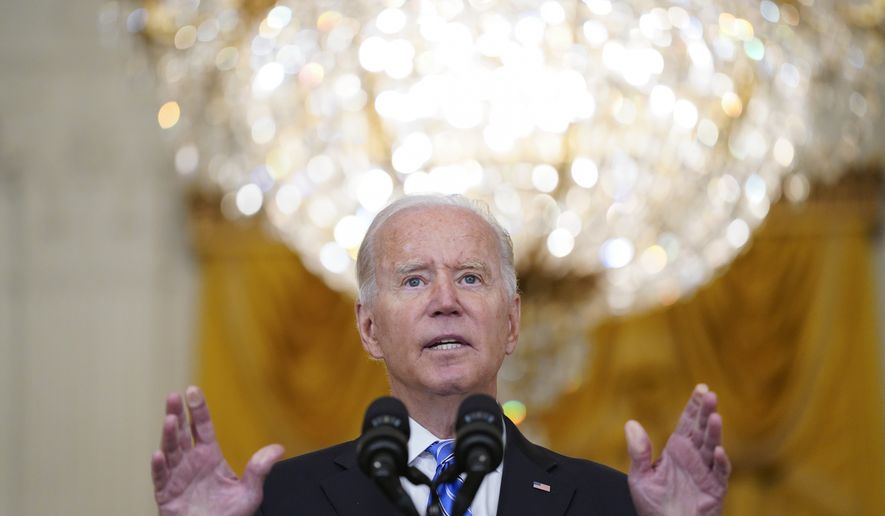The White House on Wednesday made the embarrassing move to call on OPEC and its allies to boost oil production as pump prices climb, underscoring alarm over the U.S. loss of energy independence under President Biden.
Domestic producers said Mr. Biden should have looked to them to bolster the nation’s oil supply.
Instead, Mr. Biden turned to OPEC, a cartel of 13 of the world’s largest oil producers and a handful of nonmember allies, including Russia.
Mr. Biden has limited U.S. oil production by issuing a slew of executive orders prioritizing climate change over the American energy industry.
Jason Mogdin, president of the Texas Alliance of Energy Producers, said the administration’s policies have hamstrung U.S. oil production, sending gasoline prices north by reducing supply.
“It only stings more when the president calls on Russia and Saudi Arabia to increase their energy production when we could do it right here in the United States,” he said. “His first call should have been to the American producers to meet the needs of the American consumer.”
Sen. John Cornyn, Texas Republican, went further: “Begging the Saudis to increase production while the White House ties one hand behind the backs of American energy companies is pathetic and embarrassing.”
U.S. oil production dropped to about 11.2 million barrels a day from more than 13 million barrels a day in the past year, according to the U.S. Energy Information Administration, the data and analysis arm of the Department of Energy. The EIA forecast U.S oil production to slightly increase in 2021 to 11.8 million barrels daily.
David Rapson, director of the Energy Economics Program at the University of California, Davis, said that as America emerges from the COVID-19 pandemic and oil demand increases, domestic production will need to rise as well.
“If we don’t allow domestic production to increase in response to demand, we are going to let OPEC dictate the price. That is going to be a long-term problem,” he said. “It’s a little odd to call on OPEC when prices go up, but it’s also odd to restrict production domestically.”
Pressed on whether the administration would consider requesting more domestic oil production, White House press secretary Jen Psaki said it wasn’t under consideration.
“That wasn’t an ask we made,” she said. “We are not posing a supply question domestically. Obviously, OPEC has its own unique role in the global marketplace.
“Our view is that there are steps OPEC can take,” she said. She noted that Mr. Biden’s energy policies would bring the U.S. net-zero emissions by 2050 and increase clean power use by 2035.
The Western Energy Alliance, which represents 200 oil and gas companies based in the West, predicted that the Biden administration’s moratorium on drilling on federal lands could cost the U.S. $33.5 billion in lost gross domestic product and 58,676 jobs by 2024. Those numbers are expected to swell to a GDP loss of $640 billion and 343,088 eliminated jobs by 2040.
The administration’s policies promise to increase the U.S. dependence on foreign oil, Mr. Mogdin said.
“Canceling the Keystone Pipeline makes it easier for OPEC to get into our market,” he said. “It makes Saudi Arabia, Russia and Venezuela more competitive.”
In Canada, the largest oil exporter to the U.S., Mr. Biden’s plea to OPEC was met with disdain. Sonya Savage, the minister of energy for Alberta, slammed the move.
“The Biden administration pleading with OPEC to increase oil production to rescue the United States from high fuel prices months after canceling the Keystone XL pipeline smacks of hypocrisy,” she said in a statement.
That dependence was on display Wednesday when National Security Adviser Jake Sullivan issued a statement urging OPEC to increase production.
Mr. Sullivan called OPEC and its non-OPEC allies, known as OPEC+, to increase oil production by 400,000 barrels per day, but he warned that isn’t enough to offset production cuts made early in the COVID-19 pandemic.
“While OPEC+ recently agreed to production increases, these increases will not fully offset previous production cuts that OPEC+ imposed during the pandemic until well into 2022,” Mr. Sullivan said. “At a critical moment in the global recovery, this is simply not enough.”
Separately, the White House sent a letter asking the Federal Trade Commission to scrutinize the oil industry for any illegal conduct that may contribute to an increase in gasoline prices.
Such illicit activity could include market manipulation on gas prices or mergers and acquisitions that reduce competition, Brian Deese, director of the National Economic Council, wrote in the letter.
“During this summer driving season, there have been many divergencies between oil prices and the cost of gasoline at the pump,” Mr. Deese wrote. “While many factors can affect gas prices, the president wants to ensure that consumers are not paying more for gas because of anti-competitive or other illegal practices.”
He also asked the Federal Energy Regulatory Commission, the Commodity Futures Trading Commission, the Justice Department and state attorneys general to address the issue.
Gasoline prices are rising across the country as demand increases, according to data from AAA.
The national average price for a gallon of gas was $3.185 Wednesday morning, the travel organization said. That is up from $3.144 per gallon a month ago and $2.174 a gallon during this time last year.
In May, the national average passed $3 for the first time since 2014. Gasoline demand reached its highest level of 2021 last week.
Those numbers could drop slightly as the summer vacation season ends and schools reopen, but it is not clear whether the decline would be enough to offset prices that have risen steadily over the past year.
Fueling demand is a loosening of pandemic restrictions that required workers to shelter in their homes and forced millions of Americans to cancel their travel plans.
The OPEC allies scaled back production to match the lower demand, but that reduced the oil supply, sending prices up as demand spiked this summer.
During the pandemic, crude oil prices dropped so much, they were trading at negative prices. A form of crude in Europe was being sold at $9 a barrel, its lowest price in decades, according to the U.S. Energy Information Administration.
Crude oil this week is trading at about $70 a barrel.
• Jeff Mordock can be reached at jmordock@washingtontimes.com.




Please read our comment policy before commenting.